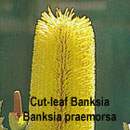Banksias grow naturally in deep, sandy to gravelly soils with excellent drainage. In heavier soils and in humid climates they can be susceptible to root rots and fungal problems. Particularly tricky in east coast gardens are the beautiful Western Australian species, such as Banksia hookeriana and B. praemorsa, with their large, spectacular flowers.
Recently, there has been an exciting breakthrough by east coast grower Nathan Kirkwood. He has developed a technique for grafting hard-to-grow species onto tough banksia understocks, such as B. integrifolia and B. ericifolia. Members of the Proteaceae family, which includes banksias, waratahs, grevilleas and hakeas, have always fascinated Nathan. He started working with banksias in particular because he was inspired and encouraged by the work of banksia expert, Roy Dawson, who was seen on Burke’s Backyard in 1990.
Nathan showed Don his basic grafting technique. To prepare the understock, he uses a razor blade to slice off the top of a seedling just above the cotyledons or rudimentary leaves. The stem of the scion (which will become the shoot system of the grafted plant) is shaved into a wedge shape and fitted into a slot at the top of the understock. The graft is then tied with budding tape. The finished grafted plant has four cotyledons.
Further information
Banksias are sold at specialist native plant nurseries and some larger garden centres. Grafted banksias are hard to find now, but will become more widely available in the future. Ask at your local nursery, or contact the grower, Subspecies Nursery, on (02) 9545 0605 for your nearest retail outlet.



